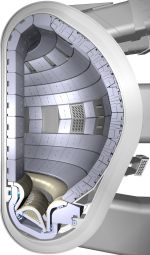EPJ D Highlight - Fusion helped by collision science
- Details
- Published on 15 January 2013

Understanding the mechanisms of electron-molecule collisions could help predict the operations inside the fusion chamber of the ITER reactor
An international team of physicists has calculated the efficiency of a reaction involving an incoming electron kicking out an electron from the metal beryllium (Be) or its hydrogen compound molecules, in an article just published in EPJ D. The efficiency, which partly depends on the electron’s incoming speed, is encapsulated in a quantity referred to as electron-impact ionisation cross sections (EICS). Electron-molecule interactions matter because they occur in a broad range of applications from the simplest like fluorescent lamps to the most complex, for example, in ionised matter found in plasmas such as latest generation screens, the outer space of the universe, and in fusion reactors.
In the future fusion reactor prototype ITER, currently being built in southern France, beryllium comes into the plasma because it is one of the constituent materials of the fusion chamber walls. The walls get eroded on contact with hot hydrogen plasma leading to the formation of beryllium in gaseous form and beryllium hydrides, BeH and BeH2, present in various forms of electric charge and state.
Given this intrusion of beryllium in the hydrogen plasma, fusion requires a knowledge of the EICS to predict and simulate its operations. The problem is that EICS are very difficult to calculate exactly. Instead, the authors relied on two approximation methods namely, the Deutsch–Märk (DM) and the Binary-Encounter-Bethe (BEB) method. These methods, albeit not new, have never before been applied to beryllium and its derivatives.
To use these models, the authors first collected the necessary input data obtained from quantum chemical calculations of characteristics such as orbital energies, kinetic energies and orbital populations. To facilitate use of their EICS by the ITER team, the authors eventually converted the numerical cross sections into equations used in simulation codes.
Electron Impact Ionization Cross Sections of Beryllium and Beryllium Hydrides. T. Maihom, I. Sukuba, R. Janev, K. Becker, T. Märk, A. Kaiser, J. Limtrakul, J. Urban, P. Mach and M. Probst (2012), European Physical Journal D, DOI 10.1140/epjd/e2012-30691-1




